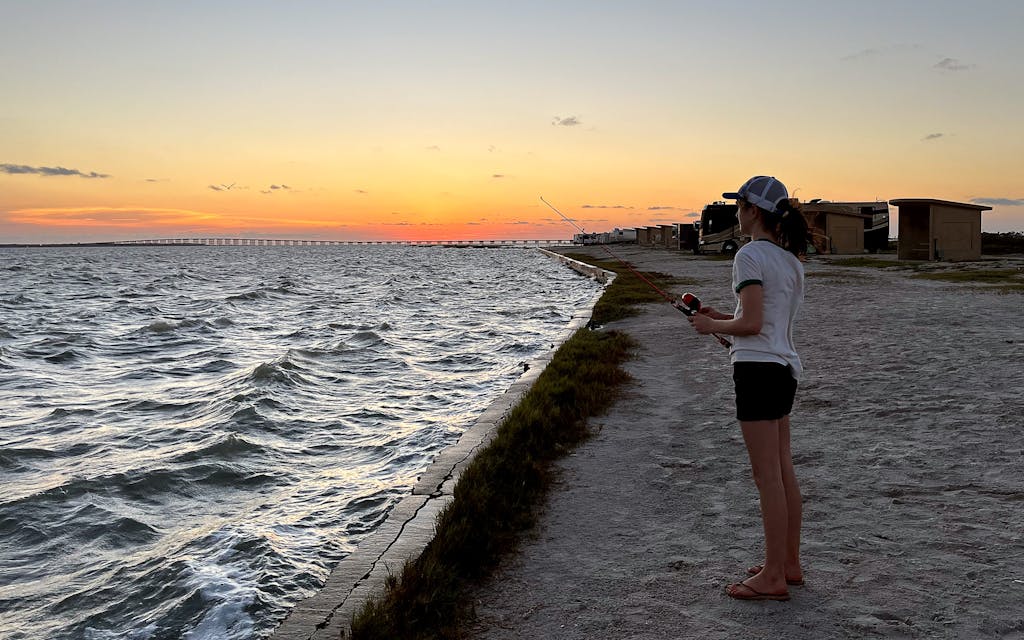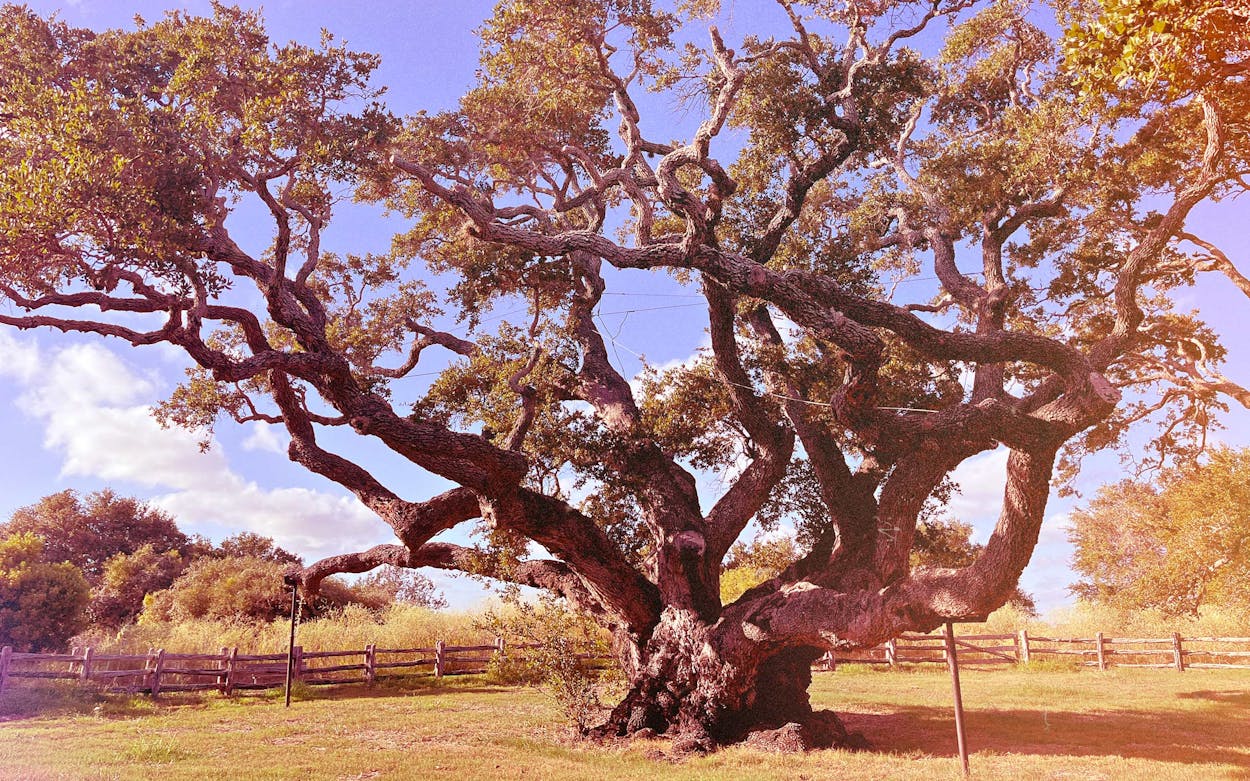You might think you know what to expect at a Texas beach park: fresh salt air, the languid sound of water lapping on the shore, and a pretty sunset. Goose Island State Park, just north of Rockport along the St. Charles and Aransas Bays, has all that—and it’s also a master class in the Gulf Coast’s ecological diversity. Somehow the petite park encompasses live oak and red bay woodlands, pockets of coastal prairie, tidal flats, salt marshes, and grasslands in a compact 321 acres. This varied landscape is a big part of why Goose Island is one of the best spots in the region for fishing and birding, with speckled trout, red drum, flounder, and more than three hundred avian species. The park is also home to the Big Tree, one of the largest and oldest live oaks in the nation. And yes, the sunsets are intense enough to impress even the most jaded traveler.
Everyone in my family of four appreciated that last point, since the temperature was still in the high nineties when we arrived in the early evening on the first day of fall. Fighting against the blustering winds at our bayside campsite, one of about a hundred in the park, we slid in tentpoles and hammered in metal stakes as the kids helped hold the edges of the tarp. A strong gust carried my five-year-old daughter several feet. By the time we finished setting up our tent, the sky was ablaze with vibrant rays, which lingered before giving way to a glowing moon and a multitude of stars. The eleven-year-old practiced handstands in the sand, and a pod of brown pelicans flew low over our heads. The moment reminded me why we continue to carve out time outdoors for our family, Texas weather be damned.
Three of us woke briefly at 3 a.m., roused by the thundering sound of the rain flap beating in a strong wind. Groggily emerging the next morning, I admired how our neighbors had wisely tucked their tent behind their picnic table. “We didn’t want our kids to blow away,” the mom quipped. If you’ll be tent camping, learn from our mistake and forgo the scenic bayside spots for one of the more than fifty sites tucked out of the wind on the mainland side of the park. This sheltered, wooded area also includes 22 walk-in tent sites for those wanting a more primitive option, as well as a group camp for scouts and other large parties.
Taking a moment to step outside in the predawn darkness, my husband was impressed to see a line of pickups already waiting in the parking lot—anglers preparing to get on the water as early as possible. Fishing is the main draw of the park, where (as in all Texas state parks) no fishing license is required if you cast from the shore or a pier. The latter is particularly impressive at Goose Island, stretching for more than 1,600 feet over the water. The bays are a nursery habitat for numerous aquatic species, and as ranger Stormy Reeves shares in an informational video about the park, “twenty-five percent of the sports fishing that happens on the Texas Gulf Coast occurs here in the Aransas Bay system.” My husband and I hadn’t grown up fishing, though we’d picked up the basics in a class led by a ranger when we visited Garner State Park this summer. There we learned rudimentary fundamentals, such as how to select bait and where to place your bobber in accordance with the depth of the fish you’re trying to catch. Similar lessons and kayaking excursions are held at Goose Island—check the park’s events calendar to see what is happening during your stay. If you don’t have fishing gear, Goose Island’s Tackle Loaner Program lends rods, reels, and tackle boxes. Watching my daughter cast her line into the sea, I thought of a quote from novelist John Buchan: “The charm of fishing is that it is the pursuit of what is elusive but attainable, a perpetual series of occasions of hope.”

By midmorning, the early bird angler crowd was long gone. Beyond the end of the pier stood a lone man fishing in knee-deep water, defying my expectation that the muddy green water would be deep that far out. Swimming is discouraged at the park, whose rocky shoreline is a mix of oyster shells, mud flats, concrete bulkheads, and marsh grass, but there are several steps down from the pier for those interested in wade fishing. Our sweat lifted with the Gulf breeze as we made our way to the end of the pier, where the Aransas Bay stretched out before us. On our way back we stopped to admire a young man reeling in an impressive redfish. “Are you going to eat it?” my husband asked. “I’m gonna take a few pictures and let it go,” he answered.
There is more to explore on the mainland side of the park, where we walked the short Turks Cap Trail. The easy path is under a mile long and has ample benches from which to watch the birds. We saw ruby-throated hummingbirds darting between the feeders at a birdwatching nook at the beginning of the trail. Our boots crunched over a trail of ancient oyster shells, flanked by scorched beautyberries and new-growth yaupon holly, promising the hope of something fresh and green emerging. Much of the trail was marked by dried, matted underbrush, which provides rest for coastal migratory birds such as warblers. Busy bluestem softly swayed with the gentle inland breeze, and a white-tailed deer strolled by.
As we drove up to the picnic area for lunch, we passed another deer and her young fawn, plus a couple turkey vultures scrounging around. The park is part of the Aransas Loop of the Great Texas Coastal Birding Trail, and the fall calendar is packed with guided hikes and other events focused on shorebirds. The endangered whooping crane winters in the nearby Aransas National Wildlife Refuge. According to park ranger Sara Rock, “Oftentimes you can get an amazing view of them across from Big Tree.” Even the most inattentive guest is still likely to spot dozens of coastal birds endemic to the region: resting on wooden perches, wading in the marshes, or floating in the wind like avian kites.
Before taking off, we drove a mile down the road to marvel at the Big Tree. Estimates of this massive live oak’s age range from one thousand to two thousand years. You can grasp its longevity in its knotted trunk and weary branches, which are supported by braces. Resting firmly with a 35-foot circumference, rising 44 feet into the Texas sky, the tree has knobby limbs and a canopy that stretches more than a hundred feet. It was grounding to stand in the presence of this enduring plant, a sentry that has stood by through generations: as the Karankawa people (according to legend) held ceremonies here, as Spanish explorers arrived in the 1500s, and through countless storms. Just as I’d done while watching my kids fish, I found myself standing still and pausing. I am used to doing—to busy beach trips filled with kayaking and paddling and surfing, to camping trips crowded with the effort of hiking all the trails. Goose Island State Park is a humble reminder of the power of being, of the elusive but attainable charm of the outdoors, when we make space for it.
- More About:
- Parks & Recs
- Rockport






